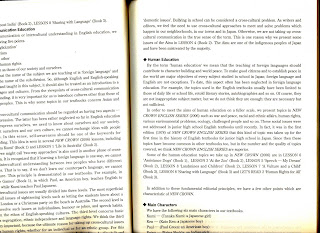Previously, with ridiculous textbooks, I've felt uncomfortable freely using examples in case someone sues me for defamation or libel or something; the textbooks we use are common across Japan however, and I'm sure an entire nation could care less about one man blogging about them. Therefore, without further ado: The problems of language teaching in Japan; part two.
So you'll have to forgive the horrible expressions, crappy cartoons and generally poor layout. They've modelled this after a Japanese comic book (they're massively popular here) and it was made in 2000. That aside, what you may immediately notice is that everything has the Japanese pronunciation written next to it. This is the best page I could find in the whole book, that is to say, this page has the least transliteration. Most pages have more, with detailed descriptions in Japanese for everything.
For the average student who could care less about English, I'm not necessarily against the idea. The point being that these students will never speak with an Englishman, or Australian, or american ever again. Leaving school means leaving English interaction. Essentially, English is a means of testing. Including the Japanese pronunciations would, at first, appear fine.
However, Japanese has fewer sounds than English, and all their sounds are accompanied with vowels. Think about this for a moment. There is no 'm.' It has to be accompanied with a vowel. 'M,' becomes one of, 'ma, me, mi, mu or mo.' That means when learning the letters of the alphabet, no one can initially pronounce the consonants correctly. This would be fine if the students learnt English in isolation, something along the lines of 'this is how it is, if you don't initially learn English along with Japanese sounds, you'll be fine.' Of course they don't. I just had a lesson - teaching the kids English sounds, where the Japanese teacher was approximating the sounds into Japanese. Some of the sounds were reaching three katakana letters in length, just for a single syllable/sound! Incredibly stupid.
The particularly annoying thing was the insistence of the teacher and student to pronounce everything incorrectly, after I had just corrected them. Learning 'm,' instead of 'mu,' took a solid minute, only for the teacher to write up 'mu,' in Japanese on the board, and all the kids to immediately embed 'mu,' in their brains - and there it will stay. Incorrect for all eternity.
On a side note, the chair I'm currently sitting in, while scanning these pictures looks like this starship. Geek, right?
So basically there is no hope for these kids to ever learn English - they will forever learn Japlish.
To be fair, I can't think of a single teacher I've met who pretends that they teach English. They all realise the errors, flaws, mistakes, misconceptions and lies perpetrated by their education system. Afterall, the teachers I work with have been through the system themselves, and have studied English to a level most of these kids won't. I would be surprised if a single student in this school went on to study English at university. There must be four hundred and fifty kids in this school.
So ultimately I have to illustrate my frustrations with another page. I decided I wouldn't pick a page meant for students, as these things are always full of holes. Instead, how about some spiel aimed at the teachers themselves, in English. To preface this, it was obviously written by a fluent speaker, and isn't a typical, crazed translation likening life to falling cherry blossoms, and the transience of youth to a flowing river.
Ok so blogspot won't upload the picture. Maybe I'll try at home.
To be continued.
Update:
This is the page I tried to upload earlier.
Check out the heading 'Human Education.'
Perhaps I was wrong about the wishy-washy Japanese style of writing; it can be, and is translated directly into English.
'English language teaching should contribute to character building and world peace.'
What the.
The words flow like rivers among an ocean of rocky precipices, deftly dodging... Ok I can't keep this up. This nonsense has no place in an English language teaching manual, especially one designed for a syllabus whereby the sole aim is to get kids through tests.
And they still haven't taught the kids how to run properly, but now they're making them jump the hurdles. Literally. They're running up to the hurdles, stopping, jumping over them, and carrying on.
Ever wondered why you've never seen a single Japanese sprinter/hurdler/sportsman/athelete? (Except for sumo, where the native Japanese competitors are beaten by south pacific islanders all the time anyway.)
Update:
This is the page I tried to upload earlier.
Check out the heading 'Human Education.'
Perhaps I was wrong about the wishy-washy Japanese style of writing; it can be, and is translated directly into English.
'English language teaching should contribute to character building and world peace.'
What the.
The words flow like rivers among an ocean of rocky precipices, deftly dodging... Ok I can't keep this up. This nonsense has no place in an English language teaching manual, especially one designed for a syllabus whereby the sole aim is to get kids through tests.
And they still haven't taught the kids how to run properly, but now they're making them jump the hurdles. Literally. They're running up to the hurdles, stopping, jumping over them, and carrying on.
Ever wondered why you've never seen a single Japanese sprinter/hurdler/sportsman/athelete? (Except for sumo, where the native Japanese competitors are beaten by south pacific islanders all the time anyway.)



Why are the south sea islanders so massive? - discuss
ReplyDelete